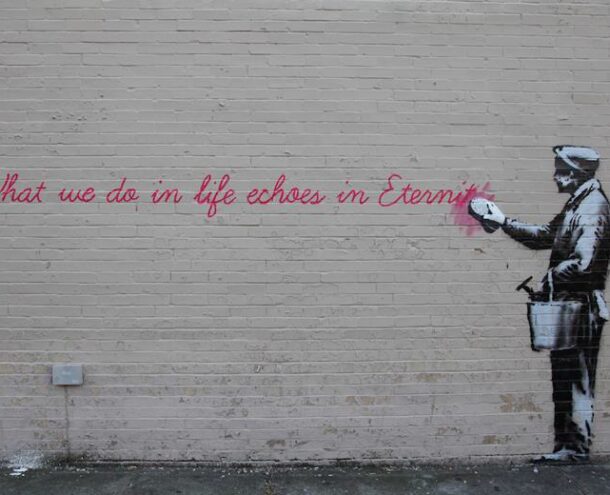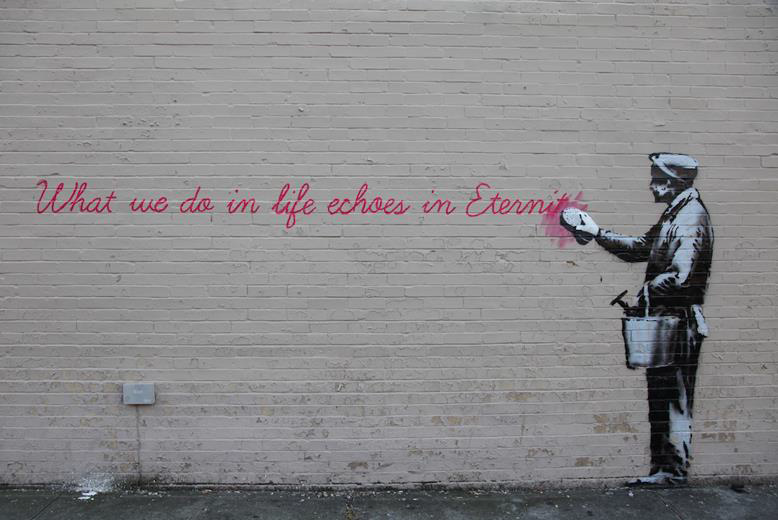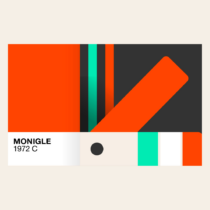What the Banksy Brand Teaches Us

Monigle takes a closer look at brand development through careful cultivation
As October 2013 came to an end, so too did the temporary New York residency of the anonymous British artist Banksy. Known for his anti-establishment views and dark humor, Banksy started out as an underground, urban graffiti artist who quickly became recognized for his irreverent and anti-establishment images and slogans stenciled on the sides of public buildings, tunnels, bridges and even vehicles. Recently he has embraced non-graffiti works including film and sculpture, and his prints and paintings have been sold at auction for hundreds of thousands of dollars: a meteoric rise for someone who started out in the not-exactly-legal trade of graffiti art!
Banksy’s work is compelling not only because of its subversive nature, but also because of the many lessons it can teach us about brand development. Following in the paths of graffiti artists such as Jean-Michel Basquiat and Keith Haring, Banksy saw an “opportunity within a crime.” Vandalism, long considered to be a scourge of cities, was transformed into highly-valued art. He achieved this by maintaining strict anonymity, while still promoting his residencies in various cities through his publicist and his web site — all the while continuing to create provocative works of art. Banksy has gone from a graffiti artist to being a true one-man brand, whose name alone adds immediate market value to anything he touches.
Two such examples of Banksy’s brand value are both amusing and educational. On October 12th a booth was set up in New York’s Central Park to sell nameless spray painted art works for $60 each. Hundreds of people walked by the booth, seemingly uninterested in or unimpressed by the wares, and only a few stopped to buy. However, when it was later revealed that Banksy was the man behind it, all the paintings that had been sold that day went up in value considerably — some say to over $30,000 apiece! In another performance, he bought a painting from a NY thrift shop for $50, re-worked it by adding a Nazi to an otherwise pastoral scene — typical Banksy — and then donated it back to the thrift shop. The shop auctioned the painting and it sold for $615,000 — quite the price premium that proves the considerable value behind the Banksy brand.
So how has Banksy created his incredible brand value and what does it teach us?
How Brands Can Be Tied to Banksy:
- Good Brands Have the Ability to Stand Out From the Crowd. Banksy found a unique point of artistic merit and differentiation by creating a distinctive and recognizable artistic style featuring crisp stenciled designs that clearly stand out from the typical lowbrow freehand graffiti.
- Good Brands Know Their Audience. Banksy recognized the need to build awareness for his art. He did so by laser-focused targeting of his audience — non-gallery-visiting young art buyers who appreciate avant-garde art.
- Good Brands Define Supply. Banksy’s economic rise began when he photographed his art and then sold the prints through web and direct sales to his target audience. This eventually led to gallery representation, shows and increased sales, bringing artistic legitimacy and brand value. Although most artists would have been satisfied with that level of success and validation, Banksy wasn’t. Instead, he pulled his work out of galleries, making it scarcer, more desirable and thus even more valuable to the consumer. This increased consumer brand value helped to further define his supply on the business-to-business side, by enabling him to skirt the gallery owners and improve his profit margins.
- Good Brands Continuously Build the Authentic Brand Story. Banksy built a larger legend around his brand through his strict anonymity, which created more mystery and desire in the market. His cleverly-crafted and professionally-publicized city residency periods gather still more fans who are attracted not only to his art, but also to his subversive and anonymous persona, which perfectly matches the mythology of night-striking invisible graffiti artists. In this way, although he now is a highly successful artist, he still remains authentic, rather than contrived
Tom Douglis is the Brand Strategy Director for Monigle Associates. Although not as mysterious as Banksy, his branding expertise has created incredible value for top companies around the globe.



